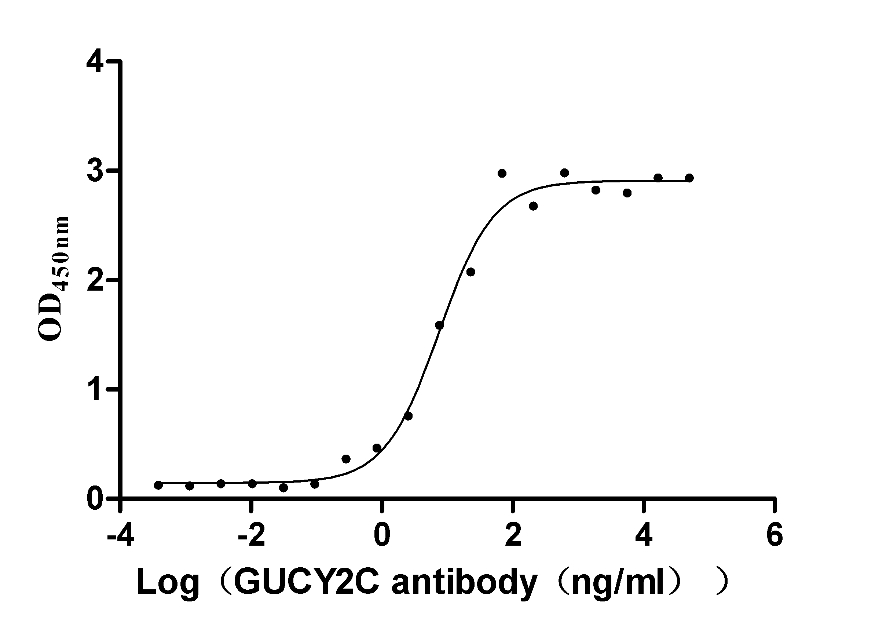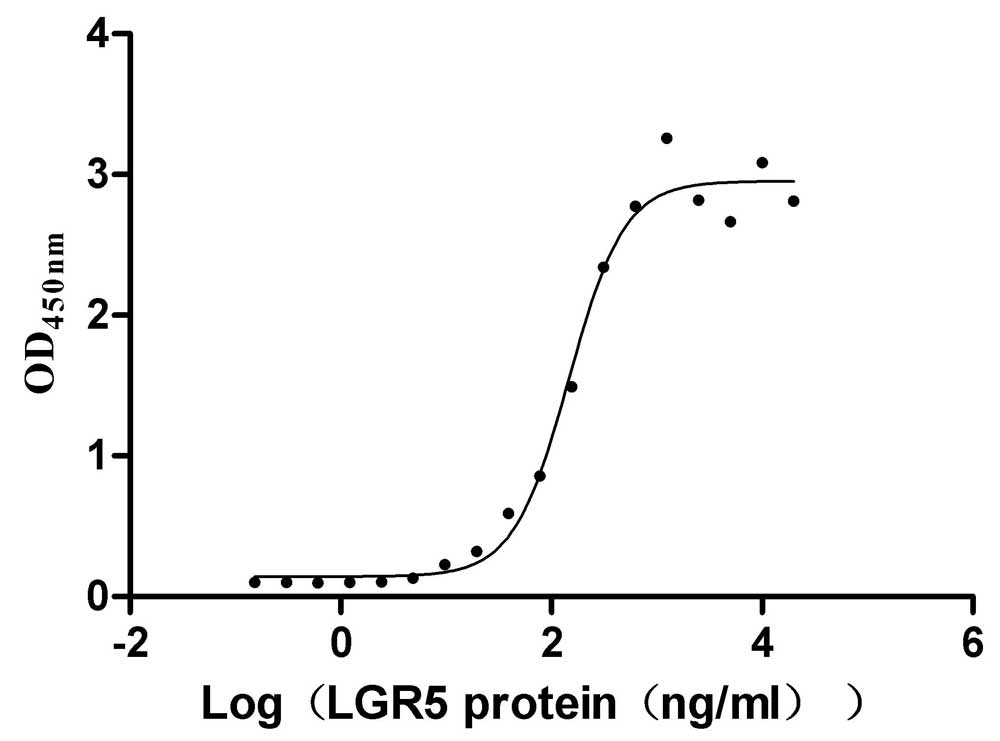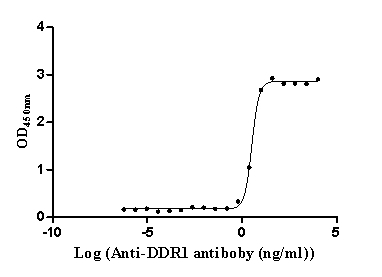Recombinant Mouse CX3C chemokine receptor 1 (Cx3cr1), partial
-
中文名称:Recombinant Mouse CX3C chemokine receptor 1(Cx3cr1),partial,Yeast
-
货号:CSB-YP897445MO1
-
规格:
-
来源:Yeast
-
其他:
-
中文名称:Recombinant Mouse CX3C chemokine receptor 1(Cx3cr1),partial,Yeast
-
货号:CSB-EP897445MO1
-
规格:
-
来源:E.coli
-
其他:
-
中文名称:Recombinant Mouse CX3C chemokine receptor 1(Cx3cr1),partial,Yeast
-
货号:CSB-EP897445MO1-B
-
规格:
-
来源:E.coli
-
共轭:Avi-tag Biotinylated
E. coli biotin ligase (BirA) is highly specific in covalently attaching biotin to the 15 amino acid AviTag peptide. This recombinant protein was biotinylated in vivo by AviTag-BirA technology, which method is BriA catalyzes amide linkage between the biotin and the specific lysine of the AviTag.
-
其他:
-
中文名称:Recombinant Mouse CX3C chemokine receptor 1(Cx3cr1),partial,Yeast
-
货号:CSB-BP897445MO1
-
规格:
-
来源:Baculovirus
-
其他:
-
中文名称:Recombinant Mouse CX3C chemokine receptor 1(Cx3cr1),partial,Yeast
-
货号:CSB-MP897445MO1
-
规格:
-
来源:Mammalian cell
-
其他:
产品详情
-
纯度:>85% (SDS-PAGE)
-
基因名:
-
Uniprot No.:
-
别名:Cx3cr1; CX3C chemokine receptor 1; C-X3-C CKR-1; CX3CR1; mCX3CR1; Fractalkine receptor
-
种属:Mus musculus (Mouse)
-
蛋白长度:Partial
-
蛋白标签:Tag type will be determined during the manufacturing process.
The tag type will be determined during production process. If you have specified tag type, please tell us and we will develop the specified tag preferentially. -
产品提供形式:Lyophilized powder
Note: We will preferentially ship the format that we have in stock, however, if you have any special requirement for the format, please remark your requirement when placing the order, we will prepare according to your demand. -
复溶:We recommend that this vial be briefly centrifuged prior to opening to bring the contents to the bottom. Please reconstitute protein in deionized sterile water to a concentration of 0.1-1.0 mg/mL.We recommend to add 5-50% of glycerol (final concentration) and aliquot for long-term storage at -20℃/-80℃. Our default final concentration of glycerol is 50%. Customers could use it as reference.
-
储存条件:Store at -20°C/-80°C upon receipt, aliquoting is necessary for mutiple use. Avoid repeated freeze-thaw cycles.
-
保质期:The shelf life is related to many factors, storage state, buffer ingredients, storage temperature and the stability of the protein itself.
Generally, the shelf life of liquid form is 6 months at -20°C/-80°C. The shelf life of lyophilized form is 12 months at -20°C/-80°C. -
货期:Delivery time may differ from different purchasing way or location, please kindly consult your local distributors for specific delivery time.Note: All of our proteins are default shipped with normal blue ice packs, if you request to ship with dry ice, please communicate with us in advance and extra fees will be charged.
-
注意事项:Repeated freezing and thawing is not recommended. Store working aliquots at 4°C for up to one week.
-
Datasheet :Please contact us to get it.
相关产品
靶点详情
-
功能:Receptor for the C-X3-C chemokine fractalkine (CX3CL1) present on many early leukocyte cells; CX3CR1-CX3CL1 signaling exerts distinct functions in different tissue compartments, such as immune response, inflammation, cell adhesion and chemotaxis. CX3CR1-CX3CL1 signaling mediates cell migratory functions. Responsible for the recruitment of natural killer (NK) cells to inflamed tissues. Acts as a regulator of inflammation process leading to atherogenesis by mediating macrophage and monocyte recruitment to inflamed atherosclerotic plaques, promoting cell survival. Involved in airway inflammation by promoting interleukin 2-producing T helper (Th2) cell survival in inflamed lung. Involved in the migration of circulating monocytes to non-inflamed tissues, where they differentiate into macrophages and dendritic cells. Acts as a negative regulator of angiogenesis, probably by promoting macrophage chemotaxis. Plays a key role in brain microglia by regulating inflammatory response in the central nervous system (CNS) and regulating synapse maturation. Required to restrain the microglial inflammatory response in the CNS and the resulting parenchymal damage in response to pathological stimuli. Involved in brain development by participating in synaptic pruning, a natural process during which brain microglia eliminates extra synapses during postnatal development. Synaptic pruning by microglia is required to promote the maturation of circuit connectivity during brain development. Acts as an important regulator of the gut microbiota by controlling immunity to intestinal bacteria and fungi. Expressed in lamina propria dendritic cells in the small intestine, which form transepithelial dendrites capable of taking up bacteria in order to provide defense against pathogenic bacteria. Required to initiate innate and adaptive immune responses against dissemination of commensal fungi (mycobiota) component of the gut: expressed in mononuclear phagocytes (MNPs) and acts by promoting induction of antifungal IgG antibodies response to confer protection against disseminated C.albicans or C.auris infection. Also acts as a receptor for C-C motif chemokine CCL26, inducing cell chemotaxis.
-
基因功能参考文献:
- CXCR1 mediates neuronal apoptotic cell death in ischemia. PMID: 29323156
- These data implicate sex differences in microglial activation in the modulation of energy homeostasis and identify CX3CR1 signalling as a potential therapeutic target for the treatment of obesity. PMID: 28223698
- Ang II up-regulates CX3CR1 expression in VSMCs via NADPH oxidase/ROS/p38 MAPK pathway and the CX3CL1/CX3CR1 axis contributes to the proliferative and pro-inflammatory effects of Ang II in VSMCs. PMID: 29356931
- CX3CR1 ablation enhanced the neurotrophic action of microglia in Mecp2KO mice PMID: 26883520
- These findings indicate that emotional and cognitive stress resilience involves CX3CR1-dependent basal and stress-induced alterations in hippocampal transcription PMID: 27890560
- The effect of CX3CR1 deletion on murine acetabular development provides suggestive evidence of a susceptibility inducing role of the CX3CR1 gene on developmental dysplasia of the hip. PMID: 29126427
- In Cx3cr1(-/-) mice, adult-born-granule-cells exhibited reduced spine density, dynamics and size, concomitantly with reduced contacts between Cx3cr1-deficient microglia and adult-born-granule-cells' dendritic shafts, along with increased proportion of microglia-contacted spines. PMID: 29251592
- reveal CX3CR1 as a novel target for the clearance of extracellular Tau PMID: 28810892
- These findings suggest that fractalkine receptor is not a universal regulator of synaptic plasticity, but rather has heterogeneous roles in specific brain regions and life stages. PMID: 28836393
- that CX3CL1-CX3CR1 signaling is a molecular mechanism capable of modulating microglial-mediated degeneration PMID: 27314452
- Increased fractalkine and its receptor CX3CR1 may cause a cross-talk between activated glial cells and neurons, playing an important role in the development of neuroinflammation in fructose-fed mice. PMID: 26765996
- CX3CR1 deficiency accelerates the development of vascular pathology in diabetic retinopathy. PMID: 27344677
- CX3CR1(-/-) mice did not become anhedonic in the "two hit" chronic stress paradigm, confirming resistance of these animals to chronic stress-induced mood alterations. However, there was no difference in stress hormone levels, open field performance and hypothalamic microglia distribution between the genotypes. Energy expenditure was increased in CX3CR1(-/-) mice, which may be related to their active coping behavior. PMID: 28736330
- Inflammatory Osteoclasts Prime TNFalpha-Producing CD4(+) T Cells and Express CX3 CR1 PMID: 27161765
- our study demonstrates that macrophages expressing a functional CX3CR1 receptor have an important and non-redundant role in controlling the abnormal intestinal inflammation that may lead to tissue damage. PMID: 27707514
- These results highlight the importance of fractalkine-CX3CR1 interaction in recruitment of macrophages into the brown adipose tissue of obese mice. PMID: 27417459
- Results indicate that deletion of CX3CR1 from microglia under resting conditions modifies brain areas with elevated cellular turnover independent of CX3CL1. PMID: 27639555
- CX3CL1 is upregulated in both human and murine tumors following VEGF signaling blockade, resulting in recruitment of CX3CR1+Ly6Clo monocytes into the tumor PMID: 28691930
- The CX3CL1/CX3CR1 system is essential for restricting coxsackievirus B3-induced myocarditis. PMID: 28800592
- Results establish an essential role for the receptor CX3CR1 in gut macrophages in resolving inflammation in the intestine, where it helps protects against colitis-associated cancer by regulating HMOX-1 expression. PMID: 28619710
- CX3CR1 significantly contributes to changes in microglia morphology in the proximal peri-infarct area following transient occlusion of the middle cerebral artery. Morphological alterations suggest a shift in microglia functionality integrated in the inflammatory response after stroke. Results show that CX3CR1 deficiency has no beneficial effect on lesion size neither it affects early functional outcome after stroke. PMID: 28061814
- Published data show that genetic deletion of CX3CR1, a microglia-specific chemokine receptor, promotes recovery after traumatic spinal cord injury in mice, a benefit achieved in part by reducing macrophage-mediated injury at the lesion epicenter. Data in the current manuscript indicate that CX3CR1 deletion changes microglia and macrophage function, creating a tissue microenvironment that enhances endogenous repair. PMID: 28264978
- this reduction in lesion formation was associated with reduced numbers of lesional SMCs but not macrophages within the transplanted Cx3cr-/- Apoe-/- aortic segment. No differences in frequencies of proliferating and apoptotic cells could be observed. These results indicate that CX3CR1 on resident vessel wall cells plays a key role in atherosclerotic plaque formation in transplanted aortic grafts PMID: 28234900
- Knockdown of the fractalkine receptor CX3CR1 in embryonic cortical precursors, or constitutive knockout of CX3CR1, causes decreased numbers of oligodendrocyte progenitor cells (OPCs) and oligodendrocytes in the postnatal cortex. PMID: 28472653
- Fractalkine-CX3CR1 signaling has been shown to protect neurons. PMID: 27814376
- In both wild-type and CX3CR1-deficient experimental autoimmune encephalomyelitis mice, NK cells are mobilized from the periphery and accumulate in the inflamed CNS. However, in CX3CR1-deficient mice, the infiltrated NK cells displayed an immature phenotype PMID: 27325505
- a crucial role of CX3CL1-CX3CR1 in experimental colitis, in particular for intestinal leukocyte recruitment during murine colitis, is reported. PMID: 27942903
- These data suggest that CX3CR1 deficiency in resident cells of the CNS affects mouse survival, HSV-1 replication control and cerebral inflammatory response whereas its deficiency in the haematopoietic system does not appear to influence the outcome of HSE. PMID: 27902351
- Deletion of Cx3cr1 had no effect on development of clinical signs or disease incubation period of prion disease. PMID: 26935332
- s provide evidence that interactions between CX3CL1 and CX3CR1 play crucial roles in determining the number of M1 macrophages within the skin of mice, which in turn can have dramatic effects on psoriasis-like inflammation. PMID: 26976687
- CX3CR1 Disruption Differentially Influences Dopaminergic Neuron Degeneration in Parkinsonian Mice Depending on the Neurotoxin and Route of Administration. PMID: 26403659
- Involvement of fractalkineCX3CR1 signaling and endothelial cell proliferation were also identified PMID: 26254180
- Some mononuclear phagocyte subsets that develop from monocytes and are distinguished by their expression of CX3CR1. CX3CR1 expression can be regulated using in vivo depletion techniques and genetic targeting. PMID: 26705686
- CD11c(+) CX3CR1(+) F4/80(-) DCs significantly increased during intestinal schistosomiasis in the ileal lamina propria PMID: 26303459
- activation of canonical Wnt signaling might contribute to the focal retinal degeneration of mouse models with Ccl2 and Cx3cr1 deficiency PMID: 26476672
- Results show that CX3CR1 knockout decreases phagocytosis in microglia resulting in decreased inflammation associated with alpha-syn internalization SUGGESTING THAT CX3CR1 is important in disease progression of synucleinopathies. PMID: 26469270
- Also icariin reduced CX3CR1 and CX3CL1 protein levels in the artery wall. In conclusion, icariin could be a potential anti-atherosclerosis agent by downregulating the expression of CX3CR1. PMID: 26802470
- Results of this study demonstrate for the first time that CX3CR1 modulates responses to mild TBI in a time-dependent manner PMID: 26329692
- Results demonstrate that dysregulated microglial responses in absence of CX3CR1 contribute to inflammatory-mediated damage of neurons in the diabetic retina PMID: 26514658
- survival of resident arterial macrophages depends on a CX3CR1-CX3CL1 axis within the vascular niche. PMID: 26642357
- CX3CR1 is important to acute skeletal muscle injury repair by regulating macrophage phagocytosis. PMID: 26443824
- This study showed CX3CR1 deficiency promotes muscle repair and rescues Ccl2(-/-) mice from impaired muscle regeneration as a result of altered macrophage function, including upregulated Apolipoprotein E (ApoE). PMID: 26632270
- Data show that fractalkine receptor CX3CR1 expression is decreased in both murine and human glioblastoma (GBM) tissue. PMID: 25987130
- Myocardial fractalkine expression was increased in myocardial infarction model. PMID: 26049921
- Mice deficient in Cx3cr1 were protected from granuloma formation and hepatic injury induced by Schistosoma japonicum eggs, as manifested by reduced body weight loss and attenuated hepatomegaly along with preserved liver function. PMID: 26035381
- neuronal Cx3cr1 may impact Alzheimer's disease-like pathology by modulating conformational state-dependent amyloid-beta-induced synaptotoxicity. PMID: 26038823
- Microbiota-mediated activation of the innate immune responses through CX3CR1 is crucial for controlling steatohepatitis progression, which recognizes CX3CR1 as an essential gatekeeper in this scenario. PMID: 26178698
- CX3CL1/CX3CR1 signaling is involved in LTP of C-fiber-evoked field potentials in the rodent spinal dorsal horn PMID: 25768734
- Results suggest fractalkine-CX3CR1 signaling pathway role in limbic seizure-induced hippocampal pathologies including microglial activation, neurodegeneration and neuroblast production PMID: 25461978
- CX3CR1 deficiency affected neither monocyte trafficking nor macrophage differentiation in vivo upon renal obstruction, but CX3CR1 expression in monocytes and macrophages was required for increases in fibrosis in obstructed kidneys. PMID: 26254342
显示更多
收起更多
-
亚细胞定位:Cell membrane; Multi-pass membrane protein.
-
蛋白家族:G-protein coupled receptor 1 family
-
组织特异性:Specifically expressed in subsets of leukocytes: expressed in monocytes, subsets of T-cells and natural killer (NK) cells in the circulation, dendritic cells, as well as in microglia in the central nervous system (CNS). Expression level subdivides blood m
-
数据库链接:
KEGG: mmu:13051
STRING: 10090.ENSMUSP00000063986
UniGene: Mm.44065
Most popular with customers
-
Recombinant Human Tumor necrosis factor ligand superfamily member 18 (TNFSF18), partial (Active)
Express system: Mammalian cell
Species: Homo sapiens (Human)
-
Recombinant Human Heat-stable enterotoxin receptor (GUCY2C), partial (Active)
Express system: Mammalian cell
Species: Homo sapiens (Human)
-
Recombinant Human R-spondin-1 (RSPO1), partial (Active)
Express system: Mammalian cell
Species: Homo sapiens (Human)
-
Recombinant Rat Microtubule-associated protein tau (Mapt) (Active)
Express system: Mammalian cell
Species: Rattus norvegicus (Rat)
-
Recombinant Human Epithelial discoidin domain-containing receptor 1 (DDR1), partial (Active)
Express system: Mammalian cell
Species: Homo sapiens (Human)
-
Recombinant Human C-type lectin domain family 4 member C (CLEC4C), partial (Active)
Express system: Mammalian cell
Species: Homo sapiens (Human)
-
Recombinant Human Serine/threonine-protein kinase receptor R3 (ACVRL1), partial (Active)
Express system: Baculovirus
Species: Homo sapiens (Human)
-
Recombinant Macaca fascicularis C-type lectin domain family 4 member C(CLEC4C), partial (Active)
Express system: Mammalian cell
Species: Macaca fascicularis (Crab-eating macaque) (Cynomolgus monkey)




















